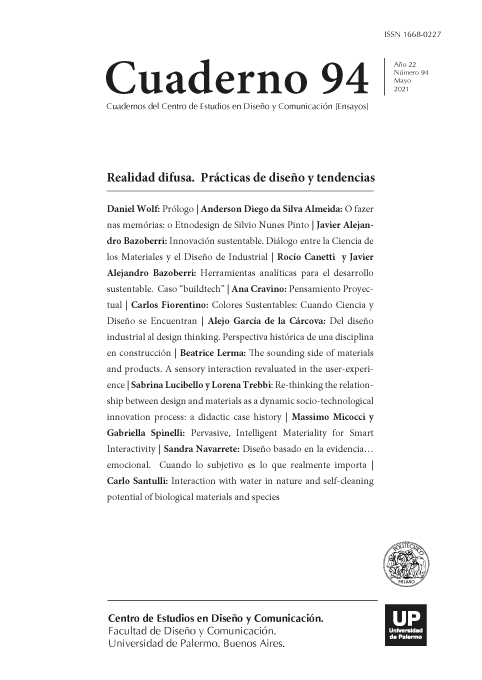Interaction with water in nature and self-cleaning potential of biological materials and species
Resumen
La autolimpieza es una característica importante de muchas especies biológicas, ampliamente investigada en la literatura biomimética, con el objetivo de ofrecerla en materiales innovadores. Para tratar de resumir las diferentes propiedades de los materiales bioinspirados que tienen un efecto autolimpiante, se han propuesto diferentes modos de clasificación. En particular, se cita una especie paradigmática, por ejemplo, "efecto de loto", "efecto pétalo de rosa", etc., o se menciona una propiedad física, como superhidrofobicidad, supeoleofobia, etc. Este trabajo considera algunas diferencias modos en los que la naturaleza implementa la autolimpieza como una forma de interacción efectiva con el agua, dependiendo de las necesidades respectivas de las diversas especies. Con este objetivo, se ha considerado una muestra de diez especies, seleccionadas entre las que han sido más investigadas en la literatura biomimética. Luego se realiza un intento de clasificación, tratando de ofrecer información para el desarrollo de nuevos materiales inspirados en la naturaleza que ofrecen propiedades de autolimpieza en diferentes condiciones de aplicación.
Citas
Autumn K, Gravish N (2008), Gecko adhesion: evolutionary nanotechnology, Phylosophical Transactions of the Royal Society A 366, pp. 1575–1590.
Ball P, (1999) Engineering shark skin and other solutions, Nature 400, 5 August 1999, pp. 507–509.
Bixler GD, Bhushan B, (2013) Fluid drag reduction with shark-skin riblet inspired microstructured surfaces, Advanced Functional Materials 23, pp. 4507–4528.
Bhushan B, Nosonovsky M, (2010) The rose petal effect and the modes of superhydrophobicity, Phylosophical Transactions of the Royal Society A 368 (1929), 28 October 2010, pp. 4713-4728.
Cheng Q, Li M, Zheng Y, Su B, Wang S, Jiang L, (2011) Janus interface materials: superhydrophobic air/solid interface and superoleophobic water/solid interface inspired by a lotus leaf, Soft Matter 7, pp. 5948–5951.
Cheng Y-T, (2005) Rodak DE, Is the lotus leaf superhydrophobic?, Applied Physics Letters 86.
Deldin J-M, Schuknecht M, (2013) The AskNature database: enabling solutions in biomimetic design, Biologically Inspired Design, Computational Methods and Tools, Goel, AK, McAdams DA, Stone R.B (eds.), Springer, pp. 17-27.
Dorrer C, Rühe J, (2008) Mimicking the Stenocara beetle’s dewetting of drops from a patterned superhydrophobic surface, Langmuir 24, 6154-6158.
Feng XQ, Gao X, Wu Z, Jiang L, Zheng QS, (2007) Superior water repellency of water strider legs with hierarchical structures: experiments and analysis, Langmuir 23, 23, 4892-4896.
Genzer J, Marmur A, (2008) Biological and synthetic self-cleaning surfaces, MRS Bulletin 33, pp. 742-746.
Hansen WR, Autumn K, (2005) Evidence for self-cleaning in gecko setae, PNAS 102 (2), 385–389.
Hasan J, Webb HK, Truong VK, Pogodin S, Baulin VA, Watson GS, Watson JA, Crawford RJ, Ivanova EP, (2013) Selective bactericidal activity of nanopatterned superhydrophobic cicada Psaltoda claripennis wing surfaces, Applied Microbiology and Biotechnology 97 (20), pp. 9257-9262.
Hu DL, Chan B, Bush JWM, (2003) The hydrodynamics of water strider locomotion, Nature 424, 7 August, pp. 663-666.
Jiang T, Guo Z, Liu W, (2015) Biomimetic superoleophobic surfaces: focusing on their fabrication and applications, Journal of Materials Chemistry A 3, pp. 1811-1827.
Johnson ER, (2010) Reinventing biological life, reinventing ‘the human’, Ephemera 10 (2),, pp. 177-193.
Knoblauch M, Peters WS, (2004) Biomimetic actuators: where technology and cell biology merge, Cellular and Molecular Life Sciences 61 (19-20), pp. 2497-2509.
Liu M, Zheng Y, Zhai J Jiang L, (2010) Bioinspired super-antiwetting interfaces with special liquid-solid adhesion, Accounts of Chemical Research 43 (3), pp. 368-377.
Liu Y, Li G, (2012) A new method for producing “Lotus Effect” on a biomimetic shark skin, Journal of Colloid and Interface Science 338 (1), pp. 235-242.
Malik FT, Clement RM, Gethin DT, Krawszik W, Parker AR, (2014) Nature's moisture harvesters: a comparative review, Bioinspiration & Biomimetics 9 (3), 031002. doi: 10.1088/1748-3182/9/3/031002.
Nishimoto S, Bhushan B, (2013) Bioinspired self-cleaning surfaces with superhydrophobicity, superoleophobicity, and superhydrophilicity, RSC Advances 3, pp. 671-690.
Parker AR, Lawrence CR, (2001) Water capture by a desert beetle, Nature 414, pp. 33–34.
Sato O, Kubo S, Gu ZZ, (2009) Structural Color Films with Lotus Effects, Superhydrophilicity, and Tunable Stop-Bands, Accounts of Chemical Research 42 (1), pp. 1–10.
Su C, (2010) Facile fabrication of a lotus-effect composite coating via wrapping silica with polyurethane, Applied Surface Science 256 (7), pp. 2122-2127.
Vincent JFV, (2014) Chapter 17 – Biomimetic Materials, in Materials Experience: Fundamentals of Materials and Design, Karana E, Pedgley O, Rognoli V, (eds.), ButterworttHeinemann, pp. 235–246.
Vincent JFV, Owers P, (1986) Mechanical design of hedgehog spines and porcupine quills, Journal of Zoology, 210 (1), pp. 55-75.
Vukusic R, Sambles JR, (2003) Photonic structures in biology, Nature 424, pp. 852-855.
Wisdom KM, Watson JA, Qu X, Liu F, Watson GS, Chen C-H, (2013) Self-cleaning of superhydrophobic surfaces by self-propelled jumping condensate, PNAS 110 (20), pp. 7992–7997.
Wu D, Wang J-N, Wu S-Z, Chen Q-D, Zhao S, Zhang H, Sun H-B, Jiang L, (2011) Three-level biomimetic rice-leaf surfaces with controllable anisotropic sliding, Advanced Functional Materials 21, pp. 2927–2932.
Zhang H, Cai C, Liu W, Li W, Zhang J, Zhao N, Xu J, (2017) Recyclable polydimethylsiloxane network crosslinked by dynamic transesterification reaction, Scientific Reports 7, Article number 11833.
Zhang L, Zhong Y, Cha D, Wang P, (2013) A self-cleaning underwater superoleophobic mesh for oil-water separation, Scientific Reports 3, n. 2326.
Los autores/as que publiquen en esta revista ceden los derechos de autor y de publicación a "Cuadernos del Centro de Estudios de Diseño y Comunicación", Aceptando el registro de su trabajo bajo una licencia de atribución de Creative Commons, que permite a terceros utilizar lo publicado siempre que de el crédito pertinente a los autores y a esta revista.


